Sử dụng lý thuyết Judd-Ofelt để phân tích phổ về cấu trúc mạng của thủy tinh lithium-sodium aluminoborate glass pha tạp ion Dy+3
Abstract
Dy3+ doped lithium-sodium aluminoborate glass (60-x) B2O3-10Al2O3-15Na2O-15Li2O-xDy2O3 (ABLN: Dy3+) are
prepared by the conventional melting procedure. Optical absorption and luminescence spectra have been measured at
room temperature. Using the Judd - Ofelt (JO) theory, the intensity parameters Ωλ (λ = 2,4,6) have been evaluated for
ABLN: Dy3+ glass. These intensity parameters are used to predict radiative properties that include electric (Sed)
magnetic (Smd) dipole line strength, radiative transition probabilities (AR), lifetime (τR), branching ratios (βR) for the
excited levels of Dy3+. In addition, the stimulated emission cross – sections (σλp) have been predicted for the transitions
4F9/2 → 6HJ (J=15/2, 13/2, 9/2).
Keywords: Aluminoborate glasses; Judd-Ofelt theory; luminescence.
Tóm tắt
Thủy tinh lithium-sodium aluminoborate pha tạp Dy3+ (60-x) B2O3-10Al2O3-15Na2O-15Li2O-xDy2O3 (ABLN: Dy3+)
được chế tạo bằng phương pháp nung nóng chảy. Phổ hấp thụ và phổ huỳnh quang được đo tại nhiệt độ phòng. Sử dụng
lý thuyết Judd – Ofelt (JO), các thông số cường độ Ωλ (λ = 2, 4, 6) đã được xác định cho thủy tinh ABLN: Dy3+. Các
thông số cường độ này được sử dụng để dự đoán các đặc tính bức xạ bao gồm lực vạch lưỡng cực điện (Sed), lưỡng
cược từ (Smd), xác suất chuyển dời bức xạ (AR), thời gian sống (τR), tỷ số phân nhánh (βR) cho các mức kích thích của
Dy3+. Ngoài ra, tiết diện phát xạ (σλp) đã được dự đoán cho quá trình các chuyển dời bức xạ: 4F9/2 → 6HJ
(J=15/2,13/2,9/2).
Từ khóa: Thủy tinh aluminoborate; lý thuyết Judd-Ofelt; huỳnh quang.
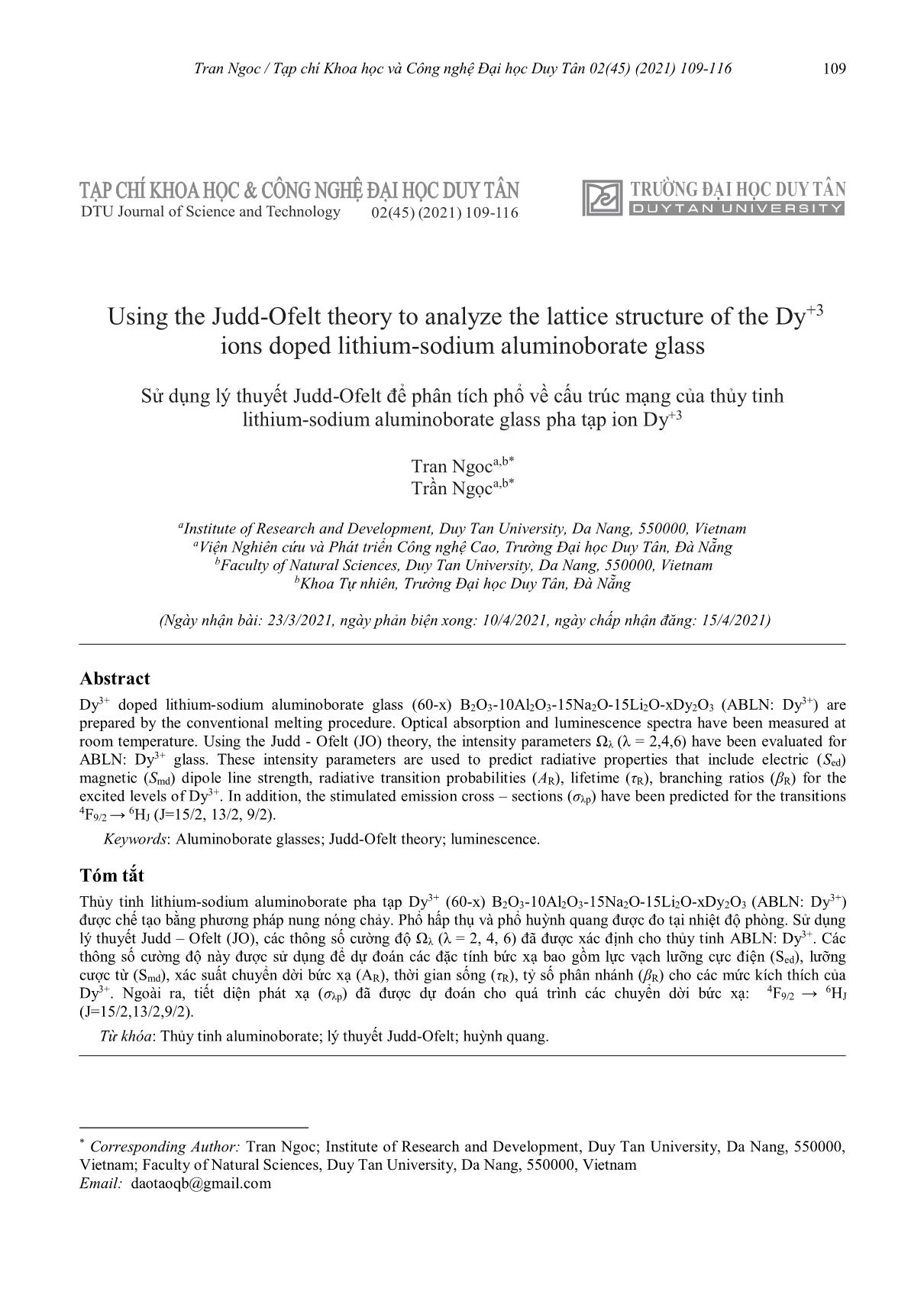
Trang 1
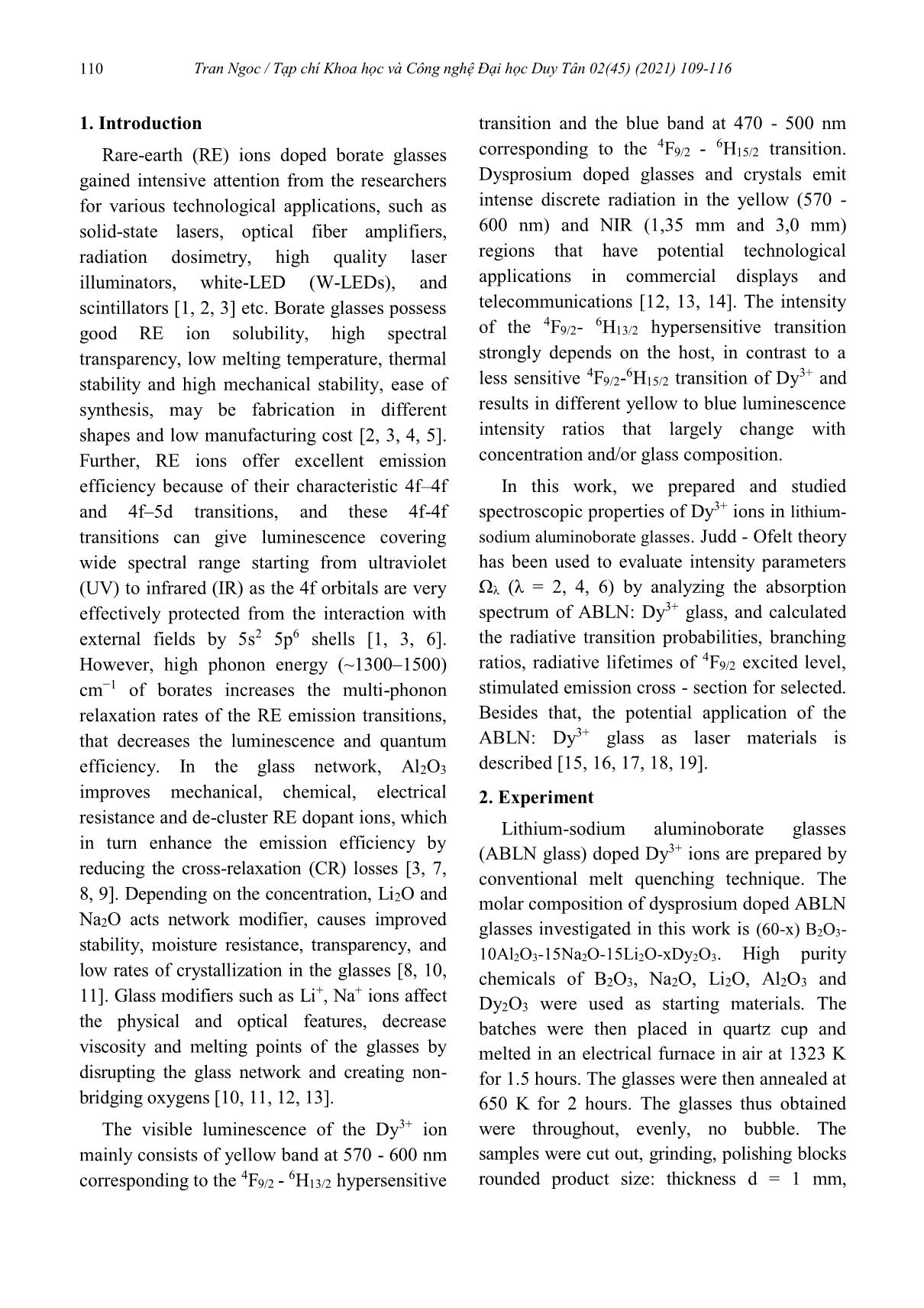
Trang 2
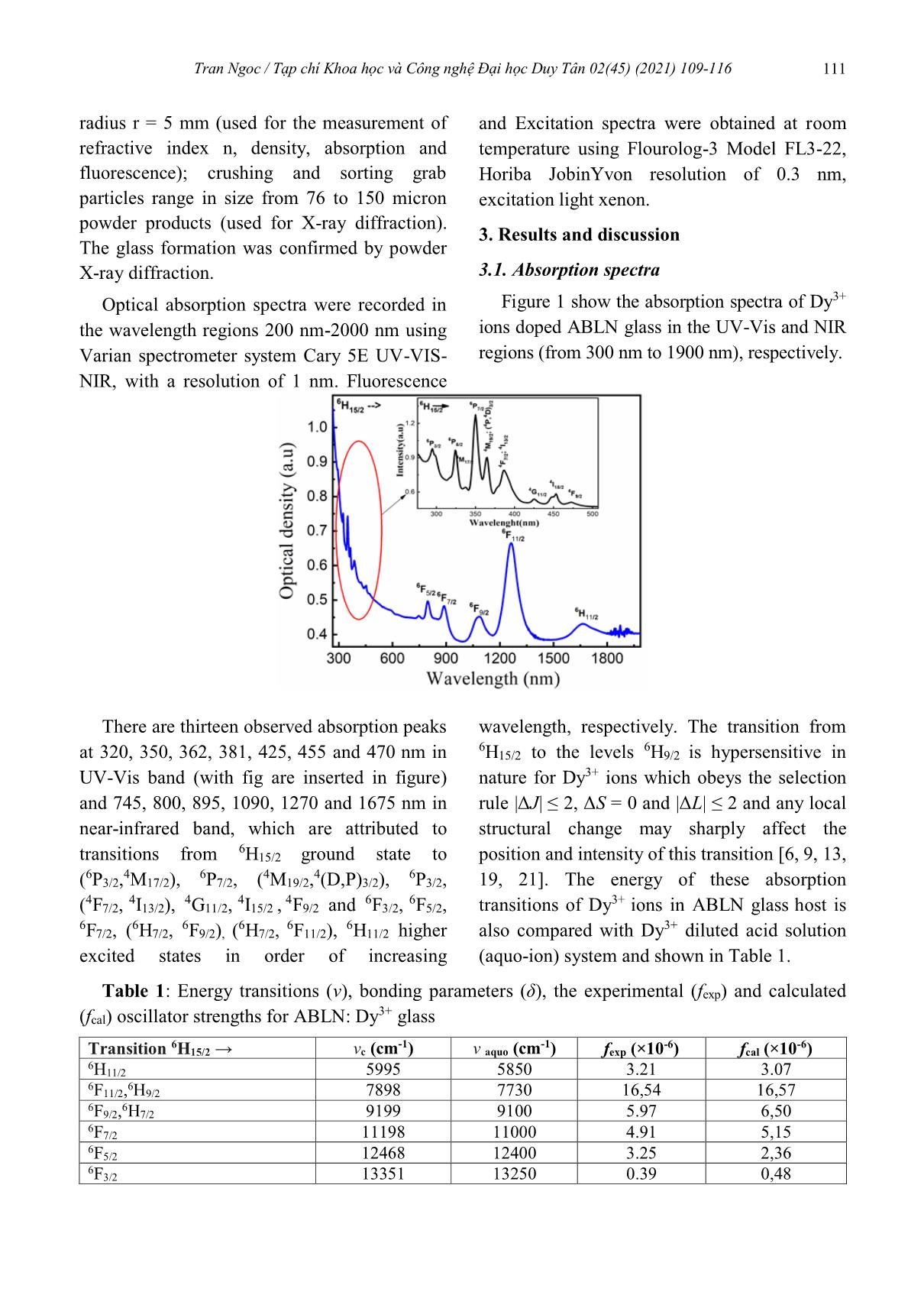
Trang 3

Trang 4
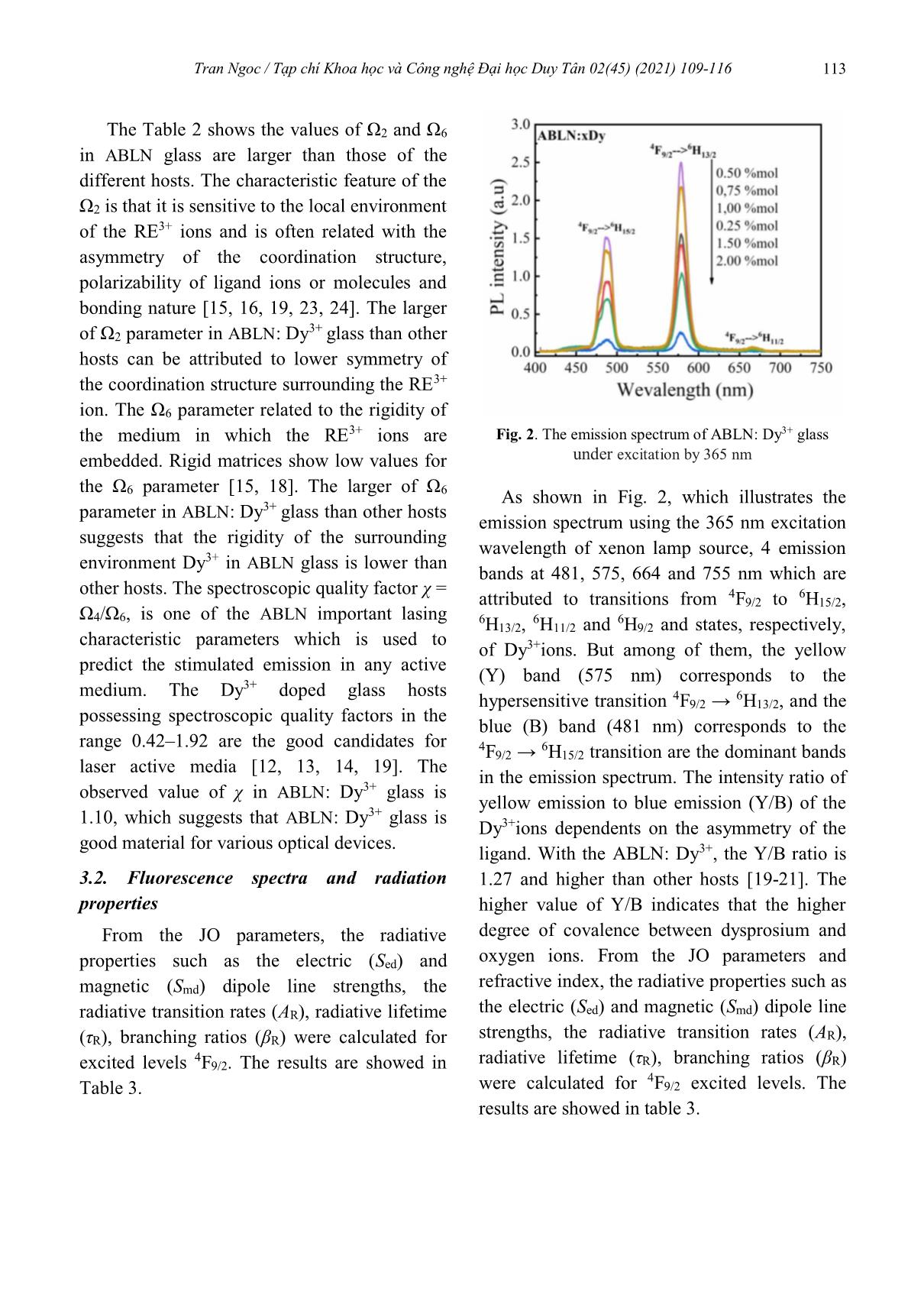
Trang 5
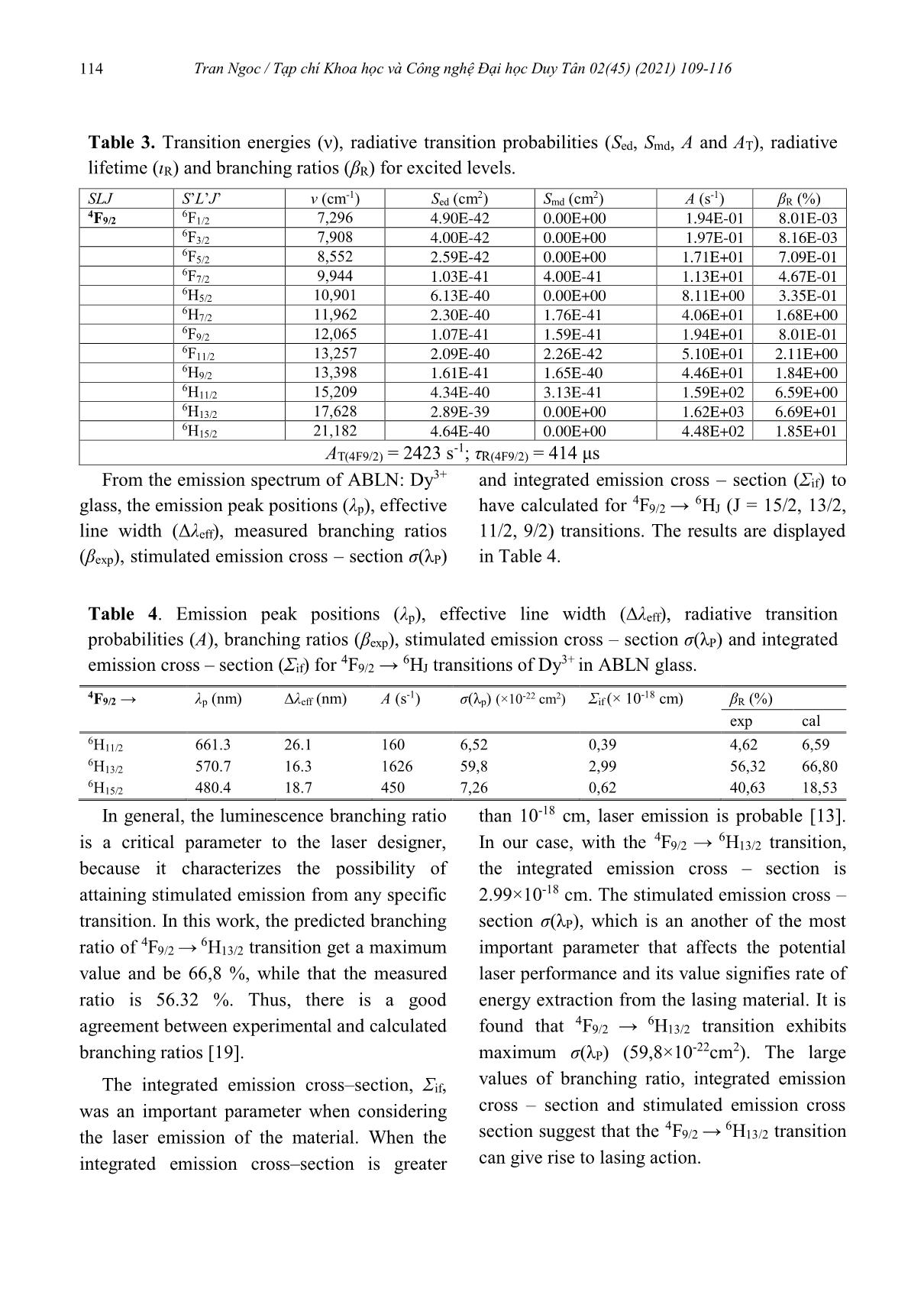
Trang 6

Trang 7
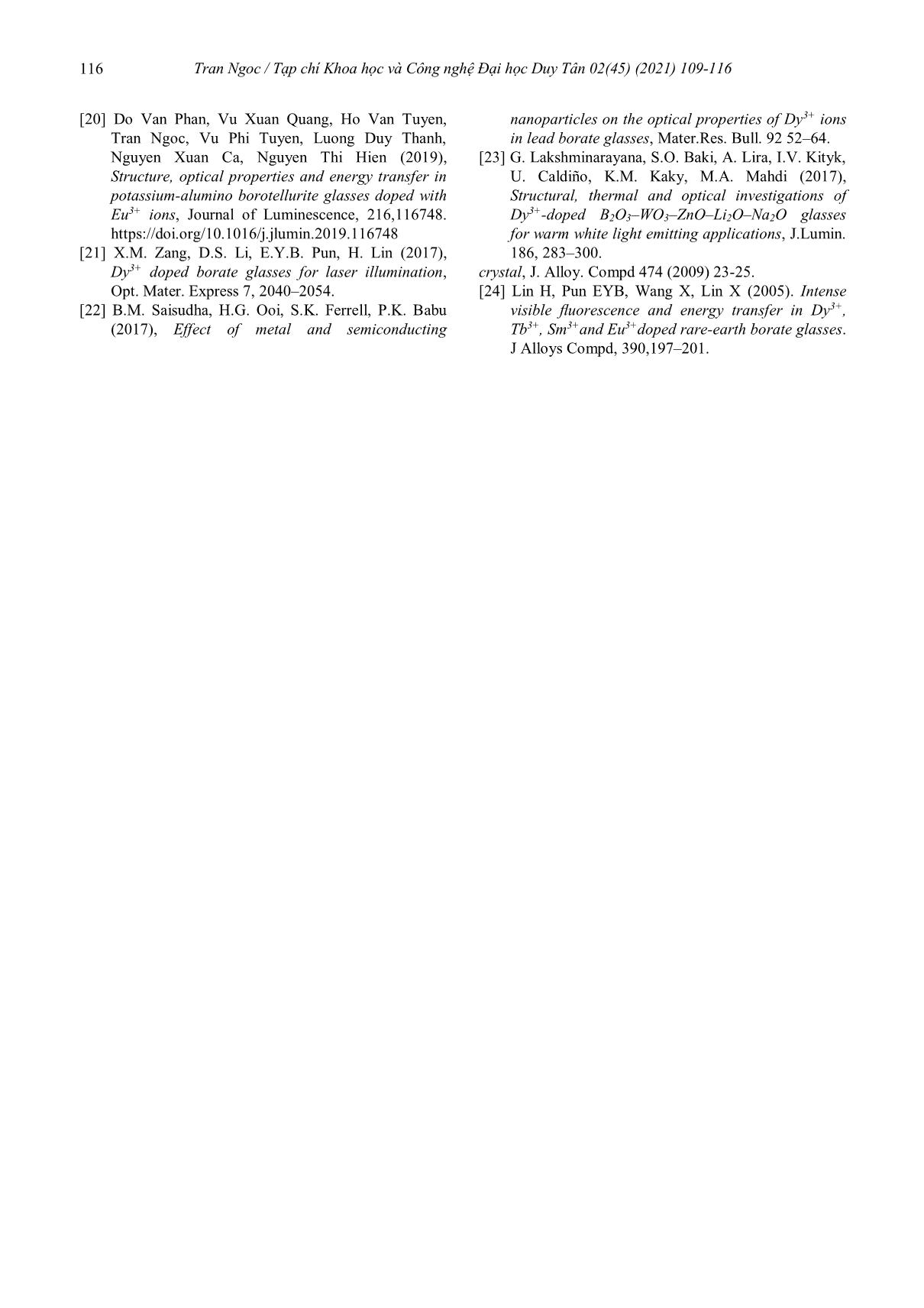
Trang 8
Tóm tắt nội dung tài liệu: Sử dụng lý thuyết Judd-Ofelt để phân tích phổ về cấu trúc mạng của thủy tinh lithium-sodium aluminoborate glass pha tạp ion Dy+3
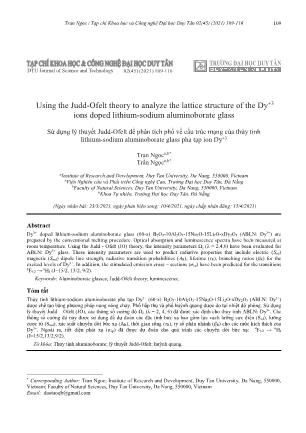
Tran Ngoc / Tạp chí Khoa học và Công nghệ Đại học Duy Tân 02(45) (2021) 109-116 109 02(45) (2021) 109-116 Using the Judd-Ofelt theory to analyze the lattice structure of the Dy+3 ions doped lithium-sodium aluminoborate glass Sử dụng lý thuyết Judd-Ofelt để phân tích phổ về cấu trúc mạng của thủy tinh lithium-sodium aluminoborate glass pha tạp ion Dy+3 Tran Ngoca,b* Trần Ngọca,b* aInstitute of Research and Development, Duy Tan University, Da Nang, 550000, Vietnam aViện Nghiên cứu và Phát triển Công nghệ Cao, Trường Đại học Duy Tân, Đà Nẵng bFaculty of Natural Sciences, Duy Tan University, Da Nang, 550000, Vietnam bKhoa Tự nhiên, Trường Đại học Duy Tân, Đà Nẵng (Ngày nhận bài: 23/3/2021, ngày phản biện xong: 10/4/2021, ngày chấp nhận đăng: 15/4/2021) Abstract 3+ 3+ Dy doped lithium-sodium aluminoborate glass (60-x) B2O3-10Al2O3-15Na2O-15Li2O-xDy2O3 (ABLN: Dy ) are prepared by the conventional melting procedure. Optical absorption and luminescence spectra have been measured at room temperature. Using the Judd - Ofelt (JO) theory, the intensity parameters Ωλ (λ = 2,4,6) have been evaluated for 3+ ABLN: Dy glass. These intensity parameters are used to predict radiative properties that include electric (Sed) magnetic (Smd) dipole line strength, radiative transition probabilities (AR), lifetime (τR), branching ratios (βR) for the 3+ excited levels of Dy . In addition, the stimulated emission cross – sections (σλp) have been predicted for the transitions 4 6 F9/2 → HJ (J=15/2, 13/2, 9/2). Keywords: Aluminoborate glasses; Judd-Ofelt theory; luminescence. Tóm tắt 3+ 3+ Thủy tinh lithium-sodium aluminoborate pha tạp Dy (60-x) B2O3-10Al2O3-15Na2O-15Li2O-xDy2O3 (ABLN: Dy ) được chế tạo bằng phương pháp nung nóng chảy. Phổ hấp thụ và phổ huỳnh quang được đo tại nhiệt độ phòng. Sử dụng 3+ lý thuyết Judd – Ofelt (JO), các thông số cường độ Ωλ (λ = 2, 4, 6) đã được xác định cho thủy tinh ABLN: Dy . Các thông số cường độ này được sử dụng để dự đoán các đặc tính bức xạ bao gồm lực vạch lưỡng cực điện (Sed), lưỡng cược từ (Smd), xác suất chuyển dời bức xạ (AR), thời gian sống (τR), tỷ số phân nhánh (βR) cho các mức kích thích của 3+ 4 6 Dy . Ngoài ra, tiết diện phát xạ (σλp) đã được dự đoán cho quá trình các chuyển dời bức xạ: F9/2 → HJ (J=15/2,13/2,9/2). Từ khóa: Thủy tinh aluminoborate; lý thuyết Judd-Ofelt; huỳnh quang. * Corresponding Author: Tran Ngoc; Institute of Research and Development, Duy Tan University, Da Nang, 550000, Vietnam; Faculty of Natural Sciences, Duy Tan University, Da Nang, 550000, Vietnam Email: daotaoqb@gmail.com 110 Tran Ngoc / Tạp chí Khoa học và Công nghệ Đại học Duy Tân 02(45) (2021) 109-116 1. Introduction transition and the blue band at 470 - 500 nm 4 6 Rare-earth (RE) ions doped borate glasses corresponding to the F9/2 - H15/2 transition. gained intensive attention from the researchers Dysprosium doped glasses and crystals emit for various technological applications, such as intense discrete radiation in the yellow (570 - solid-state lasers, optical fiber amplifiers, 600 nm) and NIR (1,35 mm and 3,0 mm) radiation dosimetry, high quality laser regions that have potential technological illuminators, white-LED (W-LEDs), and applications in commercial displays and scintillators [1, 2, 3] etc. Borate glasses possess telecommunications [12, 13, 14]. The intensity 4 6 good RE ion solubility, high spectral of the F9/2- H13/2 hypersensitive transition transparency, low melting temperature, thermal strongly depends on the host, in contrast to a 4 6 3+ stability and high mechanical stability, ease of less sensitive F9/2- H15/2 transition of Dy and synthesis, may be fabrication in different results in different yellow to blue luminescence shapes and low manufacturing cost [2, 3, 4, 5]. intensity ratios that largely change with Further, RE ions offer excellent emission concentration and/or glass composition. efficiency because of their characteristic 4f–4f In this work, we prepared and studied and 4f–5d transitions, and these 4f-4f spectroscopic properties of Dy3+ ions in lithium- transitions can give luminescence covering sodium aluminoborate glasses. Judd - Ofelt theory wide spectral range starting from ultraviolet has been used to evaluate intensity parameters (UV) to infrared (IR) as the 4f orbitals are very Ωλ (λ = 2, 4, 6) by analyzing the absorption effectively protected from the interaction with spectrum of ABLN: Dy3+ glass, and calculated external fields by 5s2 5p6 shells [1, 3, 6]. the radiative transition probabilities, branching 4 However, high phonon energy (~1300–1500) ratios, radiative lifetimes of F9/2 excited level, cm−1 of borates increases the multi-phonon stimulated emission cross - section for selected. relaxation rates of the RE emission transitions, Besides that, the potential application of the that decreases the luminescence and qu ... 6 4 P3/2, M17/2 30864 30892 3.14 2,02 1.0063; 1.63 rms = 1.09×10-6 Nephelauxetic effect- Bonding parameter The bonding parameter (δ) is defined where α is molar extinction coefficient at -1 as 1 / 100 [1, 4, 5], energy ν (cm ). The α(ν) values can be where ()/ n and nephelauxetic ratio β = calculated from absorbance A by using Lambert νc/νa, (νc and νa are energies of the – Beer’s law: A = α(ν)Cd, C is concentration corresponding transitions in the complex and [dim: L-3; units: mol-1], d is the optical path aquo-ion, respectively, and n to refers to the length [dim: L; units: cm]. n is the refractive number of levels that are used to compute index of the material, J is the total angular values) [1, 2]. Depending on the field momentum of the ground state, Ωλ are the JO 2 environmental, the bonding parameter (δ) can intensity parameters and U are the squared be received the positive or negative value doubly reduced matrix of the unit tensor indicating covalent or ionic bonding. In our operator of the rank λ = 2, 4, 6 is calculated sample, the values of and δ bonding from intermediate coupling approximation for a parameter are 1.0063 and -1.63, respectively. transition JJ ''. These reduced matrix 3+ Thus, the bonding of Dy ions with the local elements did not nearly depend on host matrix host is ionic bonding [17, 19, 20]. as noticed from earlier studies [15, 17]. All Oscillator strengths and JO parameters thirteen absorption bands have been analyzed using JO theory and were least squared fitted to The experimental (fexp) and calculation yield the best fit values for the JO parameters. oscillator strengths (fcal) of absorption bands are determined using Eq [15, 16, 18]: The results of the parameters a, b, c, for the transitions of Dy in the glass ABLN are: Ω2 = 9 fd 4,318.10 ( ) (1) -20 -20 2 -20 exp 16,30×10 ± 0.82×10 cm , Ω4 = 5,81×10 -20 2 -20 -20 ± 0.77×10 cm , Ω6 = 5.28×10 ± 0.48×10 222 2 82 mc n 2 cm . Table 2 compared the JO intensity f n U () (2) cal 3+ 3h (2 J 1) 3 n parameters obtained for ABLN: Dy glass with some of the reports on systems: Dy3+ [15 - 22]. Table 2: The JO parameters of Dy3+ ions doped various hosts -20 2 -20 2 -20 2 Host matrix 2(×10 cm ) 4(×10 cm ) 6(×10 cm ) 4/6 Ref. ABLN: Dy3+ glass 16,30 5,81 5.28 1,10 Present LYB: Dy3+ glass 12,83 3,47 3,43 1,01 [7] PKBFA: Dy3+ glass 10,41 2,29 2,07 1,10 [21] NaLTB: Dy3+ glass 9,86 3,39 2,41 1,41 [20] NaLTB: Dy3+ glass 9,25 2,87 2,29 1,25 [22] LiLTB: Dy3+ glass 8,75 2,62 2,07 1,26 [22] PKMAF: Dy3+ glass 7,04 1,73 1,57 1,10 [21] Tran Ngoc / Tạp chí Khoa học và Công nghệ Đại học Duy Tân 02(45) (2021) 109-116 113 The Table 2 shows the values of Ω2 and Ω6 in ABLN glass are larger than those of the different hosts. The characteristic feature of the Ω2 is that it is sensitive to the local environment of the RE3+ ions and is often related with the asymmetry of the coordination structure, polarizability of ligand ions or molecules and bonding nature [15, 16, 19, 23, 24]. The larger 3+ of Ω2 parameter in ABLN: Dy glass than other hosts can be attributed to lower symmetry of the coordination structure surrounding the RE3+ ion. The Ω6 parameter related to the rigidity of the medium in which the RE3+ ions are Fig. 2. The emission spectrum of ABLN: Dy3+ glass embedded. Rigid matrices show low values for under excitation by 365 nm the Ω parameter [15, 18]. The larger of Ω 6 6 As shown in Fig. 2, which illustrates the parameter in ABLN: Dy3+ glass than other hosts emission spectrum using the 365 nm excitation suggests that the rigidity of the surrounding wavelength of xenon lamp source, 4 emission environment Dy3+ in ABLN glass is lower than bands at 481, 575, 664 and 755 nm which are other hosts. The spectroscopic quality factor χ = 4 6 attributed to transitions from F9/2 to H15/2, Ω4/Ω6, is one of the ABLN important lasing 6 6 6 H13/2, H11/2 and H9/2 and states, respectively, characteristic parameters which is used to of Dy3+ions. But among of them, the yellow predict the stimulated emission in any active 3+ (Y) band (575 nm) corresponds to the medium. The Dy doped glass hosts 4 6 hypersensitive transition F9/2 → H13/2, and the possessing spectroscopic quality factors in the blue (B) band (481 nm) corresponds to the range 0.42–1.92 are the good candidates for 4 6 F9/2 → H15/2 transition are the dominant bands laser active media [12, 13, 14, 19]. The in the emission spectrum. The intensity ratio of observed value of χ in ABLN: Dy3+ glass is yellow emission to blue emission (Y/B) of the 1.10, which suggests that ABLN: Dy3+ glass is Dy3+ions dependents on the asymmetry of the good material for various optical devices. ligand. With the ABLN: Dy3+, the Y/B ratio is 3.2. Fluorescence spectra and radiation 1.27 and higher than other hosts [19-21]. The properties higher value of Y/B indicates that the higher From the JO parameters, the radiative degree of covalence between dysprosium and properties such as the electric (Sed) and oxygen ions. From the JO parameters and magnetic (Smd) dipole line strengths, the refractive index, the radiative properties such as radiative transition rates (AR), radiative lifetime the electric (Sed) and magnetic (Smd) dipole line (τR), branching ratios (βR) were calculated for strengths, the radiative transition rates (AR), 4 excited levels F9/2. The results are showed in radiative lifetime (τR), branching ratios (βR) 4 Table 3. were calculated for F9/2 excited levels. The results are showed in table 3. 114 Tran Ngoc / Tạp chí Khoa học và Công nghệ Đại học Duy Tân 02(45) (2021) 109-116 Table 3. Transition energies (ν), radiative transition probabilities (Sed, Smd, A and AT), radiative lifetime (ιR) and branching ratios (βR) for excited levels. -1 2 2 -1 SLJ S’L’J’ ν (cm ) Sed (cm ) Smd (cm ) A (s ) βR (%) 4 6 F9/2 F1/2 7,296 4.90E-42 0.00E+00 1.94E-01 8.01E-03 6 F3/2 7,908 4.00E-42 0.00E+00 1.97E-01 8.16E-03 6 F5/2 8,552 2.59E-42 0.00E+00 1.71E+01 7.09E-01 6 F7/2 9,944 1.03E-41 4.00E-41 1.13E+01 4.67E-01 6 H5/2 10,901 6.13E-40 0.00E+00 8.11E+00 3.35E-01 6 H7/2 11,962 2.30E-40 1.76E-41 4.06E+01 1.68E+00 6 F9/2 12,065 1.07E-41 1.59E-41 1.94E+01 8.01E-01 6 F11/2 13,257 2.09E-40 2.26E-42 5.10E+01 2.11E+00 6 H9/2 13,398 1.61E-41 1.65E-40 4.46E+01 1.84E+00 6 H11/2 15,209 4.34E-40 3.13E-41 1.59E+02 6.59E+00 6 H13/2 17,628 2.89E-39 0.00E+00 1.62E+03 6.69E+01 6 H15/2 21,182 4.64E-40 0.00E+00 4.48E+02 1.85E+01 -1 AT(4F9/2) = 2423 s ; τR(4F9/2) = 414 μs 3+ From the emission spectrum of ABLN: Dy and integrated emission cross – section (Σif) to 4 6 glass, the emission peak positions (λp), effective have calculated for F9/2 → HJ (J = 15/2, 13/2, line width (Δλeff), measured branching ratios 11/2, 9/2) transitions. The results are displayed (βexp), stimulated emission cross – section σ(λP) in Table 4. Table 4. Emission peak positions (λp), effective line width (∆λeff), radiative transition probabilities (A), branching ratios (βexp), stimulated emission cross – section σ(λP) and integrated 4 6 3+ emission cross – section (Σif) for F9/2 → HJ transitions of Dy in ABLN glass. 4 -1 -22 2 -18 F9/2 → λp (nm) ∆λeff (nm) A (s ) σ(λp) (×10 cm ) Σif (× 10 cm) βR (%) exp cal 6 H11/2 661.3 26.1 160 6,52 0,39 4,62 6,59 6 H13/2 570.7 16.3 1626 59,8 2,99 56,32 66,80 6 H15/2 480.4 18.7 450 7,26 0,62 40,63 18,53 In general, the luminescence branching ratio than 10-18 cm, laser emission is probable [13]. 4 6 is a critical parameter to the laser designer, In our case, with the F9/2 → H13/2 transition, because it characterizes the possibility of the integrated emission cross – section is attaining stimulated emission from any specific 2.99×10-18 cm. The stimulated emission cross – transition. In this work, the predicted branching section σ(λP), which is an another of the most 4 6 ratio of F9/2 → H13/2 transition get a maximum important parameter that affects the potential value and be 66,8 %, while that the measured laser performance and its value signifies rate of ratio is 56.32 %. Thus, there is a good energy extraction from the lasing material. It is 4 6 agreement between experimental and calculated found that F9/2 → H13/2 transition exhibits -22 2 branching ratios [19]. maximum σ(λP) (59,8×10 cm ). The large values of branching ratio, integrated emission The integrated emission cross–section, Σif, was an important parameter when considering cross – section and stimulated emission cross 4 6 the laser emission of the material. When the section suggest that the F9/2 → H13/2 transition integrated emission cross–section is greater can give rise to lasing action. Tran Ngoc / Tạp chí Khoa học và Công nghệ Đại học Duy Tân 02(45) (2021) 109-116 115 4. Conclusion [6] J. Pisarska (2009), Optical properties of lead borate glasses containing Dy3+ ions, J. Phys. Condens. Dy3+doped lithium-sodium aluminoborate Matter 21, 285101/1–6. glasses were prepared by melt quenching [7] E. Kaewnuam, N. Wantana, H.J. Kim, J. Kaewkhao (2017), Development of lithium yttrium borate glass technique and investigated through the doped with Dy3+ for laser medium, W-LEDs and absorption and photoluminescence spectra. The scintillation materials applications, J. Non-Cryst. negative value of bonding parameter δ shows Solids 464, 96–103. 3+ [8] H.H. Xiong, L.F. Shen, E.Y.B. Pun, H. Lin (2014), that the bonding of Dy ions with the local High-efficiency fluorescence radiation of Dy3+ in host is ionic bonding. JO theory has been alkaline earth borate glasses, J. Lumin. 153, 227–232. applied to determine the intensity parameters [9] Tripathi G, Rai VK, Rai SB, Spectroscopy and upconversion of Dy3+ doped in sodium zinc by analyzing the absorption spectra. The larger phosphate glass, Spectrochim Acta A 3+ of Ω2 parameter and Y/B ratio in ABLN: Dy 2005;62:1120–4. glass than other hosts can be attributed to lower [10] Tanabe S, Kang J, Hanada T, Soga N (1998), Yellow/blue luminescences of Dy3+doped borate symmetry of the coordination structure glasses and their anomalous temperature variations, surrounding the RE3+ ion. The large of the J Non-Cryst Solids, 239:170–5. spectroscopic quality (χ) suggests that ABLN: [11] S.A. Saleema, B.C. Jamalaiah, M. Jayasimhadri, A. 3+ Srinivasa Rao,Kiwan Jang, L. Rama Moorthy Dy glass is good material for various optical (2011), Luminescent studies of Dy3+ ion in alkali devices. The large values of branching ratio, lead tellurofluoroborate glasses; Journal of integrated emission cross – section and Quantitative Spectroscopy & Radiative Transfer, pp. 78–84. stimulated emission cross section suggest that [12] Surendra Babu S, Babu P, Jayasankar CK, Siewers 4 6 the F9/2 → H13/2 transition can give rise to W, Wortmann G (2011), Optical spectroscopy of lasing action. Dy3+: phosphate and fluorophosphates glasses. Opt Mater, 31, 624–31. References [13] Sardar DK, Bradley WM, Yow RM, Gruber JB, Zandi B (2004), Optical transitions and absorption [1] Christane Görller, Walrand and K. Binnemans intensities of Dy3+ (4f9) in YSGG laser host. J (1998), Spectral intensities of f – f transition, Lumin, 106:195–203. Handbook on the Physics and Chemistry of Rare [14] Yang Z, Li B, He F, Luo L, Chen W (2008), Earths. Vol.25, pp 101 – 252. Concentration dependence of Dy3+1.3 mm [2] Carnall W.T., Fields P.R., and Rajnak K (1968), luminescence in Ge–Ga–Sb–Se glasses. J Non-Cryst Electronic Energy Levels in the Trivalent Solids, 354:1198–200. 3+ 3+ 3+ 3+ Lanthanide Aquo Ions. I. Pr , Nd , Pm , Sm , [15] Judd BR (1962), Optical absorption intensities of 3+ 3+ 3+ 3+ Dy , Ho , Er , and Tm , J. Chem. Phys, 49, 10, rare earth ions, Phy Rev, 127:750–61. 4424-4442. [16] Jørgensen CK, Reisfeld R (1983). Judd–Ofelt [3] P.P. Pawar, S.R. Munishwar, S. Gautam, R.S. Gedam parameters and chemical bonding. J Less-Common (2017), Physical, thermal, structural and optical Met. 93,107–12. 3+ properties of Dy doped lithium alumino-borate [17]. Wang D., Guo Y., Wang Q., Chang Z., Liu J., Luo J glasses for bright W-LED, J. Lumin. 183 79-88. (2009), Judd-Ofelt analysis of spectroscopic [4] P.V. Do, T. Ngoc, N.X. Ca, L. D. Thanh, P. T. T. 3+ properties of Tm in K2YF5 , Journal of Alloys and Nga, T. T. C. Thuy, N. V. Nghia (2021), Study of Compounds, 474, 1–2, 23-25 3+ 3+ spectroscopy of Eu and energy transfer from Ce [18] Ofelt GS (1962). Intensities of crystal spectra of 3+ to Eu in sodium-zinc-lead-borate glass, Journal of rare-earth ions. J Chem Phys, 37, 511–20. Luminescence, 229, 117660. [19] Vu Phi Tuyen, Vu Xuan Quang, Phan Van Do, https://doi.org/10.1016/j.jlumin.2020.117660 Luong Duy Thanh, Nguyen Xuan Ca, Vu Xuan [5] P.V. Do, V.P.Tuyen, V.X. Quang, L. X.Hung, L.D. Hoa, Le van Tuat, Le Anh Thi, Masayuki Nogamia Thanh, T. Ngoc, N. V. Tam (2016),; Investigation of (2019), An in-depth study of the Judd-Ofelt analysis, spectroscopy and the dual energy transfer spectroscopic properties and energy transfer of 3+ mechanisms of Sm doped telluroborate glasses, Dy3+ in alumino-lithium-telluroborate glasses, Optical Materials, 55-62-67. Journal of Luminescence, 210-435-443, https://doi.org/10.1016/j.optmat.2021.03.023 https://doi.org/10.1016/j.jlumin.2019.03.009. 116 Tran Ngoc / Tạp chí Khoa học và Công nghệ Đại học Duy Tân 02(45) (2021) 109-116 [20] Do Van Phan, Vu Xuan Quang, Ho Van Tuyen, nanoparticles on the optical properties of Dy3+ ions Tran Ngoc, Vu Phi Tuyen, Luong Duy Thanh, in lead borate glasses, Mater.Res. Bull. 92 52–64. Nguyen Xuan Ca, Nguyen Thi Hien (2019), [23] G. Lakshminarayana, S.O. Baki, A. Lira, I.V. Kityk, Structure, optical properties and energy transfer in U. Caldiño, K.M. Kaky, M.A. Mahdi (2017), potassium-alumino borotellurite glasses doped with Structural, thermal and optical investigations of 3+ 3+ Eu ions, Journal of Luminescence, 216,116748. Dy -doped B2O3–WO3–ZnO–Li2O–Na2O glasses https://doi.org/10.1016/j.jlumin.2019.116748 for warm white light emitting applications, J.Lumin. [21] X.M. Zang, D.S. Li, E.Y.B. Pun, H. Lin (2017), 186, 283–300. Dy3+ doped borate glasses for laser illumination, crystal, J. Alloy. Compd 474 (2009) 23-25. Opt. Mater. Express 7, 2040–2054. [24] Lin H, Pun EYB, Wang X, Lin X (2005). Intense [22] B.M. Saisudha, H.G. Ooi, S.K. Ferrell, P.K. Babu visible fluorescence and energy transfer in Dy3+, (2017), Effect of metal and semiconducting Tb3+, Sm3+and Eu3+doped rare-earth borate glasses. J Alloys Compd, 390,197–201.
File đính kèm:
 su_dung_ly_thuyet_judd_ofelt_de_phan_tich_pho_ve_cau_truc_ma.pdf
su_dung_ly_thuyet_judd_ofelt_de_phan_tich_pho_ve_cau_truc_ma.pdf

